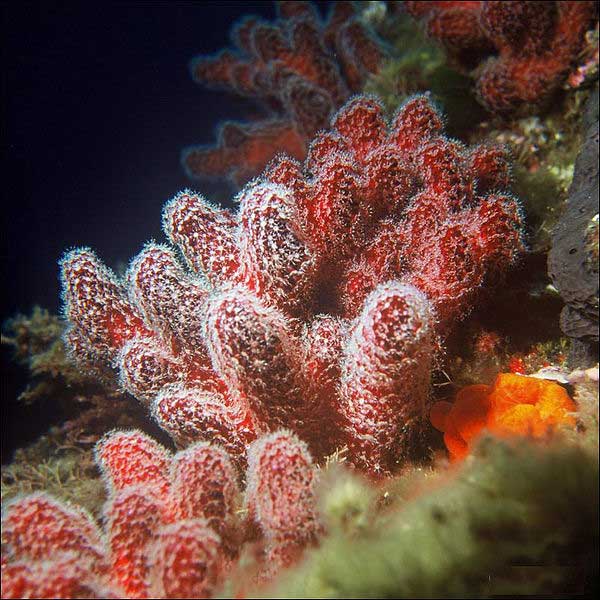
Alcyonium palmatum (*)
Superregnum: Eukaryota
Cladus: Unikonta
Cladus: Opisthokonta
Cladus: Holozoa
Regnum: Animalia
Phylum: Cnidaria
Classis: Anthozoa
Subclassis: Alcyonaria
Ordo: Alcyonacea
Subordo: Alcyoniina
Familia: Alcyoniidae
Subfamilia: Alcyoniinae
Genus: Alcyonium
Species: Alcyonium palmatum
Name
Alcyonium palmatum Pallas, 1766
Vernacular names
català: Maneta
italiano: Alcione palmato
Alcyonium palmatum or red dead man's fingers is a species of soft coral in the family Alcyoniidae.
Description
Red dead man's fingers is a colonial coral forming clumps of red fleshy masses of finger-like lobes. The surface layer include many sclerites which form a crust.[2] The individual polyps are white and translucent, and project from the leathery surface when feeding, giving the colony a furry appearance.[3] By swallowing or ejecting water an entire colony can expand or shrink considerably.
Distribution and habitat
Red dead man's fingers is found along the Mediterranean and Atlantic coasts of north west Europe from Portugal to Norway. The polyps live in colonies attached to bedrock, boulders, stones and occasionally the shells of crabs and gastropods. They are most plentiful in areas with strong water movement and where there is insufficient sunlight for algae to predominate. They are usually found in the sublittoral zone down to about fifty metres.[1]
Biology
The colonies of red dead man's fingers are nearly always either male or female, although a small number of hermaphrodite colonies are found. Colony growth occurs mainly in the first half of the year with the polyps becoming inactive in late summer, and the base tissue turning reddish or brownish due to the growth of algae and hydroids on the surface. At this time the gonads are developing and spawning occurs in December and January.
The polyps feed at various times of the day with their tentacles extended. They are suspension feeders gathering plankton from the water with the help of cilia, and absorbing oxygen at the same time.[1]
References
"Encyclopedia of Life". Eol.org. Archived from the original on 2010-05-25. Retrieved 2012-09-27.
"Taxonomy Identification". Marlin.ac.uk. Archived from the original on 2012-04-02. Retrieved 2012-09-03.
"Encyclopedia of Marine Life of Britain and Ireland". Habitas.org.uk. Retrieved 2012-09-27.
Retrieved from "http://en.wikipedia.org/"
All text is available under the terms of the GNU Free Documentation License

